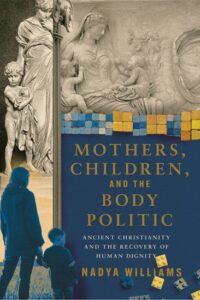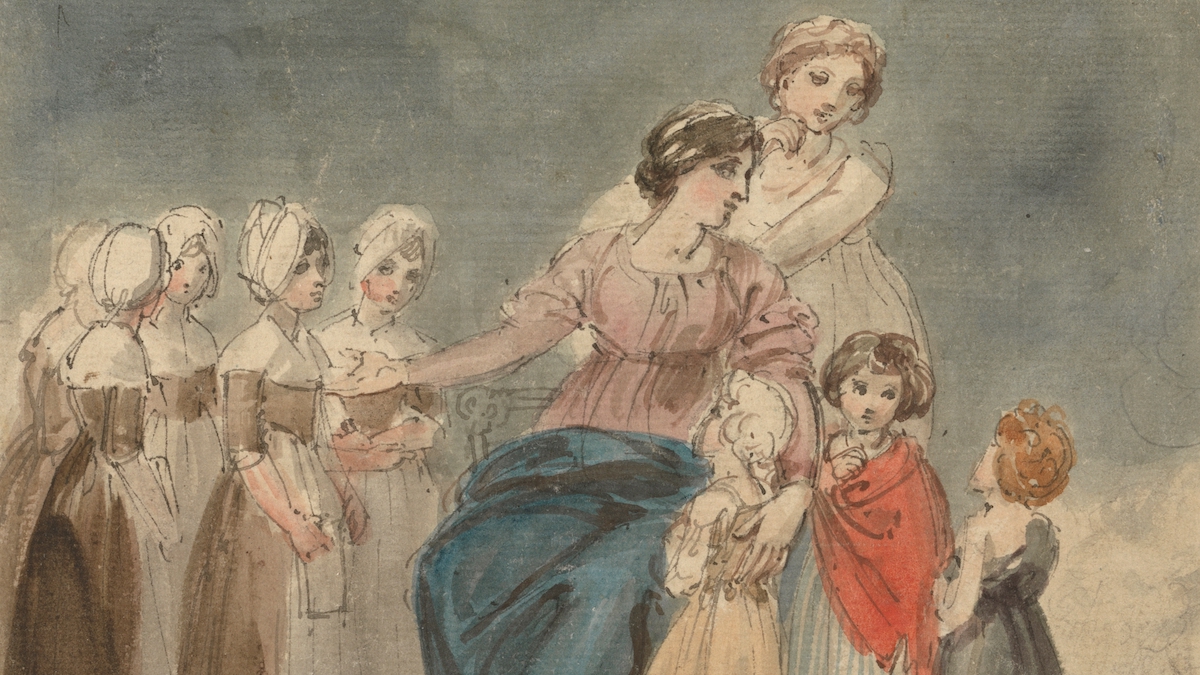Monica Klem and Madeleine McDowell, Pity For Evil: Suffrage, Abortion, and Women’s Empowerment in Reconstruction America. New York: Encounter Books, 2023. 328 pp. $34.99.
Twenty-five-year-old Dr. Charlotte Lozier was practicing medicine in New York City in November 1869 when she was approached by a stranger who made a shocking request. This married plantation owner named Andrew Moran from South Carolina had traveled to New York to secure an abortion for an eighteen-year-old girl, whom he had impregnated out of wedlock. Lozier sat in shock as Moran “with great effrontery and every-day, off-hand business air,” proposed that she “bring out premature delivery.” He offered to pay her well and protect her “from any possible legal consequences” in the case that his child’s mother died in the act. Lozier responded that he had come to the wrong place for such a “shameful, revolting unnatural and unlawful purpose.” After appealing with the girl for the life of her child and offering every aid in the extent of her power, she called the police.
This event, which resulted in the arrest and trial of Andrew Moran and was reported in the leading feminist newspaper, The Revolution, perfectly captures the challenges and opportunities for first-wave feminism during the final decades of the nineteenth century. First, the double standard of sexual ethics left women to bear the social and economic consequences for male sexual deviance. Second, the relative absence of women in specialized fields such as medicine and education resulted in a condition where a well-to-do businessman from South Carolina could mistake Lozier for an abortionist, rather than a physician. Third, financial disparities made women who became pregnant out of wedlock highly vulnerable. In the face of social ostracism and economic deprivation, abortion seemed to many the only way out—a fact to which the rising rates of abortion testified. Some, however, like Charlotte Lozier, were determined to help women resist.
This is just one of the many stories recounted in Monica Klem and Madeleine McDowell’s new book, Pity For Evil: Suffrage, Abortion, and Women’s Empowerment in Reconstruction America. It is the story of the nineteenth-century women who did not simply accept the status quo but fought back.
An Impressive Scholarly Contribution
At 328 pages and with 72 pages of endnotes, the volume represents a thoroughly researched and impressive contribution to the field of nineteenth-century history and women’s studies. As the authors explain,
This book examines the narrow moment in time when women’s rights advocates and anti-abortion campaigners worked in tandem to improve the conditions of society for women and to save the lives of unborn children by decreasing the prevalence of abortion. It was a moment of extraordinary diversity in the women’s rights movement, and yet a moment of extraordinary unity in the agreement among sociomedical investigators, women involved in charity, and women’s rights advocates on the social factors driving abortion and the structural causes to which its incidence could be ascribed.
The book draws its subject matter from The Revolution, a pioneering newspaper owned by Susan B. Anthony and edited by Elizabeth Cady Stanton and Parker Pillsbury, first published on January 8, 1868. With topics ranging from abortion to women’s advances in medicine and education to philanthropic efforts to establish homes for destitute mothers, every chapter of Pity for Evil draws its inspiration from some discussion in that newspaper. The result is a fascinating introduction to first-wave feminism just before the turn of the twentieth century.
Alongside well-known figures in the women’s rights movement, such as Anthony and Stanton, Klem and McDowell introduce readers to lesser known but no less important female leaders in medicine. Readers meet Dr. Marie Zakrzewska, who founded the New England Hospital for Women and Children in 1862; Dr. Anita Tyng, America’s first female licensed surgeon; Dr. Anna Densmore, who worked for women’s elevation by founding the first woman’s club in America, “Sorosis”; and Dr. Lozier, who, as previously mentioned, practiced medicine in New York City.
All of these women opposed abortion, supported women’s suffrage, and advocated for greater educational and economic opportunities for women. Yet equality in and of itself was not the end goal for these women. Rather, they saw it as a necessary precondition for the attainment of virtue, self-mastery, and the fulfilment of duties.
Fighting the Root Causes of Abortion
As Klem and McDowell’s scholarship demonstrates, rising rates of abortion and infanticide in the nineteenth century prompted doctors to address it as a women’s issue. Doctors like Meredith Reese and William Sanger viewed women who had abortions as victims, not perpetrators, and thus spoke of women who “suffered abortion.” That a woman would voluntarily undergo an abortion was unthinkable to these social reformers. They thus focused on the social problems—economic conditions, industrialization, declining marriage rates—that resulted in abortions. They knew that creating safe homes and state-run hospitals for unmarried mothers was more conducive to protecting infants from abortion than putting women in jail. The Revolution’s articles on abortion demonstrate the concrete ways in which feminists of this era advocated for women’s economic, marital, and political rights, while unabashedly opposing abortion.
The book also highlights the elevation of women in the medical profession, telling the stories of pioneering doctors like Marie Zakrzewska. By founding the New England Hospital for Women and Children, Zakrzewska provided educational opportunities and medical care for unmarried women. For Zakrzewska, it was not enough that abortion was illegal; she sought to make it unnecessary by providing a viable alternative. Similarly, women’s clubs, such as Sorosis, founded orphanages to provide care for children born out of wedlock, with the goal of decreasing abortions.
In 1868, “Working Woman’s Suffrage Association” (WWA) was formed, with the help of Anthony and Stanton. Its purpose was to work for the elevation of women and secure the right to vote. For working women, who often faced unfair wages and blatant sex discrimination, Anthony believed that associational life was critical for mutual assistance. The WWA rallied in defense of Hester Vaughn, a young girl unjustly sentenced to hanging for infanticide. Her case, they believed, represented all the unfairness of the nineteenth century toward young working women, whose plight could only be prevented by a fundamental change in social conditions. Eventually, after a campaign in The Revolution and a mass meeting in New York City, Vaughn was pardoned.
Klem and McDowell highlight several unconventional yet highly successful efforts to help women facing crisis pregnancies by harnessing the power of interpersonal bonds. The early feminists organized a variety of asylums and institutions to combat rising rates of abortion and infanticide, which they referred to as a “lamentable waste of human life.” Formed in 1867, one such institution, the Massachusetts Infant Asylum (MIA), took in deserted infants and orphans and gave single-mothers an alternative to the dismal infant fatality rates of the state-run almshouses. Rather than housing all infants together, MIA relied on foster parents to provide individualized care for infants. This drastically reduced the burden of care and increased infant life expectancy. “The object of our Asylum,” wrote Lucy Sewall in 1870, “should be not only to save all the infant life we can, but also to help, in our small way, in solving the great problem of how to prevent the terrible mortality that occurs everywhere among children under one year.”
In Boston, Liliam Freeman Clarke and the Society for Helping Destitute Mothers and Children (SHDMI) supported mothers and children who faced poverty and the social stigma of illegitimacy by connecting them with others who faced the same challenges. To the 83 women it enrolled in its first year, the SHDMI provided more than charity—it provided peer-relationships and support to friendless women in a lonely city, restoring the dignity often taken from these women by men, and commending their inherent dignity as mothers. As the authors write, “These vulnerable women had every motivation to destroy their children before or after birth—and the SHDMI took care of them over that time.” In creative ways, activists like Clarke helped countless mothers to realize their own inherent dignity as they learned to better care for their children.
The Seed of the Pro-Abortion Turn
Toward the end of the book, Klem and McDowell draw on Victoria Woodhull and Tennessee Claflin’s publication, Woodhull & Claflin’s Weekly, to examine the ways in which eugenics began to influence the women’s movement during the final decades of the nineteenth century. Although they too strongly opposed abortion, Woodhull and Claflin’s moral theories paved the ground for moral relativism and eugenics to gain a foothold in the feminist movement. Relying on now debunked theories of “heredity,” Woodhull argued that an unloved child was effectively already aborted. Thus, Woodhull could argue on the one hand, as she did in an 1870 article, “that it is just as much a murder to destroy life in its embryotic condition, as it is to destroy it after the fully developed form is attained, for it is the self-same life that is taken,” while in 1873 calling children born to unloving parents “monstrosities” whose number society was bound to reduce.
The contrast between this view and Lillian Clarke’s confidence that working-class mothers could be reformed and restored to motherly dignity could not be starker. As the authors conclude, Woodhull’s insufficient moral theory is to blame for later permissive attitudes towards abortion. Although still an outlier at the time, it paved the way for the dramatic shift in the way most feminists would come to view abortion in the mid-to-late twentieth century. Already, by the early twentieth century, even the SHDMI had shifted its focus away from helping women as individuals to effecting social change more broadly. Taking its cues from the growing eugenics movement, the SHDMI began referring to some mothers as “defectives,” incapable of motherhood, and destined for institutionalization and sterilization.
Pity For Evil bears all the marks of a fair-minded historical project. It reconstructs the world of its subjects and sheds light on their values and priorities without any attempt at forcing facts to suit preconceived agendas.
The authors raise numerous questions, some of which the book answers and others which remain in desperate need of answers. How can a pro-woman movement work toward legal and social conditions in which abortions become unnecessary because of the dignity, support, and honor bestowed on motherhood and childbearing? How do sexual double standards continue to affect modern society? What other twentieth-century shifts led feminists to embrace abortion as a central pillar of the movement?
If nothing else, Monica Klem and Madeleine McDowell challenge readers to realize that amid debates over policy, those looking to carry on the mantle of women like Dr. Charlotte Lozier, Susan B. Anthony, and Elizabeth Cady Stanton must never lose sight of each individual and the power of compassion to change the trajectory of a person’s life.



